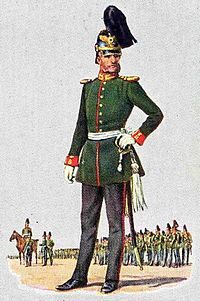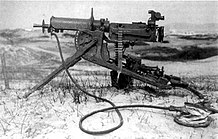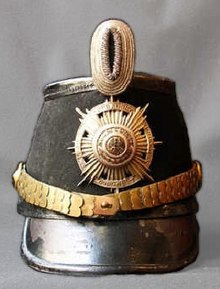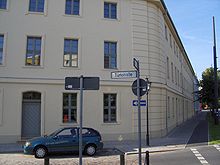Guard Jäger Battalion (Prussia)
|
Hunters on foot, Jäger-Corps on foot, Jäger-Regiment, Guard-Jäger-Battalion |
|
|---|---|
 Officer of the Guard-Jäger Battalion around 1850 |
|
| active | 1744 as a company , 1762 as a battalion , 1785 as a regiment until 1806 surrender, then the New Prussian Guard Jäger battalion |
| Country | Prussia |
| Branch of service | infantry |
| Former locations | Mittenwalde , until 1773 also Teupitz , then also Zossen |
| Origin of the soldiers | 18th century: canton-free, forester sons and hunter boys under 5 feet 6 inches in height |
| owner | Commanders: 1740 Major Egmont von Chasôt , Colonel 1750 Ludwig von der Osten , 1751 Colonel Wilhelm Ludwig von Aweyde , 1756 Major Karl von Hardwig , 1759 Major Thomas von Baader , 1759 Captain Friedrich Wilhelm von Gaudi , 1760 Captain Philipp Ludwig Siegmund Bouton des Granges , 1761 Major General Friedrich von Anhalt , 1778 Major General des Granges (from 1785 regiment chief), 1790 Colonel Karl Friedrich von Voss , 1805 Colonel Johann David Ludwig von York |
| Tribe list | until 1806: Old Prussian infantry regiments |
| Butcher |
Seven Years War
involved in almost all operations of all corps
Bavarian Succession War coalition wars |
The Guard Jäger Battalion was a New Prussian Jäger battalion , which stood in the tradition of the old Prussian Jäger Corps and was set up in Prussia in 1744 by Friedrich II . In 1808 it became the Jäger Battalion No. 1, which was named Guard Jäger Battalion . It subsequently belonged to the Guard Corps of the Royal Prussian Army until 1918 .
history
Origins and military police on foot
On November 24, 1740, King Friedrich II of Prussia issued an order for the establishment of Rheinsberg Castle in Brandenburg to the overseer Schenck of the Jägerhof in Potsdam. He was appointed Capitaine de Guides and should provide the Prussian Army with good signposts.
On June 15, 1744, Frederick the Great set up the Hunters Corps on foot , recruited from the local forest staff and their sons. The initially 144 hunter strong unit, which brought its own armament (the rifled hunting rifles were at that time clearly superior to the smooth-barreled muskets of the line infantry in terms of accuracy), grew to 300 men by the Seven Years' War and was divided into two companies in 1757. In 1760 both were wiped out by Russian Cossacks near Charlottenburg through incorrect leadership and evasion across open terrain, but immediately afterwards they were re-established as four companies. After the war, the corps was again reduced to two companies , to grow in 1773 with five companies in battalion strength . In 1778 a sixth company was set up. On January 1, 1784, a cabinet order was issued to rededicate the battalion to a regiment of ten companies.
The regiment went under with the Blücher corps in 1806 . Some companies escaped.
Wars of Liberation and the New Prussian Army
In 1808 the remaining companies were combined in the Guard Jäger Battalion. They then proved themselves in the Wars of Liberation . It covered - on their own - the retreat behind the Katzbach and thus saved the Prussians and Russians from a catastrophe. At the Battle of the Nations near Leipzig it was they who conquered the suburb of Möckern in a tough house-to-house battle, thereby denying the French reserves access to Leipzig and thus having a significant share in the victory.
In 1808 the locations were Berlin , 1812 Breslau , 1814 Berlin and from 1818 the Prussian residence in Potsdam . The battalion consisted of trained hunters . When used flexibly, their abilities should support the line infantry in war . Proven hunters were accepted into the state forest service after completing their service .
The battalion belonged to the 1st Guard Infantry Brigade in Potsdam in the 1st Guard Division (Berlin) of the Guard Corps (Berlin). From October 1, 1902, the battalion was assigned the Guard Machine Gun Division No. 1.
From today's perspective, the later Chancellor Otto von Bismarck is probably the most famous guard hunter. But if you consider that he began his service as a one-year-old volunteer in Potsdam in 1838 and was transferred to Jäger Battalion No. 2 in Kulm in Pomerania in the fall and that battalion was later renamed Pommersches Jäger Battalion “Fürst Bismarck” No. . 2 , it seems at least questionable whether this has always been the case.
The battalion was also used in the German-Danish War in 1864 and in the Prussian-Austrian War in 1866.
Franco-German War
On July 15, 1870, mobilization for the Franco-German War was ordered in Prussia . The Guard Jäger Battalion belonged to the 2nd Army, which was commanded by Prince Friedrich Karl . It was transported from Potsdam by rail to Mannheim and from there marched immediately on Metz . As early as August 18, the battalion fought its first battle as part of the avant-garde . It ended victoriously with the storming of St. Privat , which forced the French to retreat to the fortress of Metz . After the enclosure of the fortress, the battalion was assigned to the newly formed Meuse Army, which delivered the battle of Sedan to the French on September 1st . Here, too, the Guard Jäger Battalion played a major role in the victory. On January 18, 1871, a delegation of the battalion took part in the solemn proclamation of the King of Prussia as German Emperor in Versailles . On June 18, the victorious troops, including the Potsdamer Jäger, entered the festively decorated new German capital of Berlin .

Around 1900 the Guard Jäger Battalion was commissioned to test the newly introduced machine gun and make it ready for the front. Another technical innovation, the bicycle, was first tested and used by the hunters.
First World War
After the mobilization in 1914, the active battalion was ready to march in full strength on August 4 at 6 p.m. At 11.11 p.m. the train rolled west from Potsdam. On August 6, the soldiers arrived in Belgium. This was followed by an eight-day march to the front, sometimes with daily marching performances of over 40 km. On August 15th the battalion at Dinant had its baptism of fire in this war. After some fierce fighting, the battalion crossed the French border at Tout Vent on August 26th. On September 20, the battalion attacked at La-Ville-aux-Bois. The guard hunters suffered heavy losses (87 dead, 143 wounded, the commander Major Hans von Fabeck himself seriously wounded). After a break, the battalion was relocated to Alsace in April 1915 with a strength of 43 officers and 1,117 non-commissioned officers and men . There it was used at the height of Hartmannsweiler Kopf , where it was used for a long time in trench warfare. On October 14, 1916, the battalion was moved to Macedonia . There the Entente tried to take action against the southern front of the Central Powers .
The hunters managed to withstand enemy attacks at 1050 near Prilep. Seven heavy attacks with heavy artillery preparation failed. In February 1918 the battalion returned to the Western Front . In the Vosges they attacked the large-scale preparations for Operation Michael in the north of the front. The place of use at Hartmannsweilerkopf was called "Jägertanne". From November 4th the regiment withdrew to Germany. After numerous difficulties, for example the officers could not prevent the formation of a workers 'and soldiers' council , the Potsdam home garrison was reached on November 13, 1918.
The war formations of the Guard Jäger Battalion established in 1914 were the Guard Reserve Jäger Battalion and the Reserve Jäger Battalion No. 15 .
Whereabouts
Numerous Guard fighters claimed after the demobilization of the Freikorps Potsdam and were reflected in the subsequent period up to May 1919 left socialist for the national government uprisings. On June 15, 1919, the battalion held its last parade to mark the 175th anniversary and was disbanded on September 30, 1919.
The tradition of the battalion was continued in the Reichswehr by the 6th Company of the 9th (Prussian) Infantry Regiment and later in the Wehrmacht until 1945 by the 9th Infantry Regiment.
In the Bundeswehr, the memory of the guard hunters was initially kept by the Independent Panzerjäger Company 440 in Wuppertal , after its dissolution in 1981 the 2nd Company of the 533 Tank Battalion and from 1991 the 2nd Company of the 533 Hunter Battalion in Düren, which was dissolved in 1996 . From 2004 to 2006 the Potsdam Homeland Security Battalion 842 (evolved from Security Battalion 4422 in Trier) carried the Potsdam Jäger. Today the memory of the Guard Jäger Battalion is being preserved by the 3rd Company of the Staff and Telecommunications Battalion of the Bundeswehr Operations Command in Potsdam. This hunter company, in its function as a security company, is deployed to the command and control command of the German Armed Forces in the Henning von Tresckow barracks.
Commanders
| Rank | Surname | date |
|---|---|---|
| Colonel | Heinrich von Witzleben | December 25, 1808 to December 27, 1809 |
| Major / Lieutenant Colonel | Friedrich Wilhelm von Jagow | December 28, 1809 to March 9, 1813 |
| major | Florian von Seydlitz-Kurzbach | March 14th to May 30th, 1813 (entrusted with the tour) |
| major | Florian von Seydlitz-Kurzbach | June 1 to December 13, 1813 |
| Lieutenant colonel | Job from Witzleben | December 14, 1813 to October 9, 1815 |
| Major / Lieutenant Colonel / Colonel |
August Wilhelm von Neumann-Cosel | October 10, 1815 to March 29, 1831 |
| Major / Lieutenant Colonel / Colonel | Karl von Knobloch | March 30, 1838 to August 23, 1848 |
| Major / Lieutenant Colonel / Colonel | Gustav von Arnim | August 24, 1848 to October 19, 1854 |
| Lieutenant Colonel / Colonel | Heinrich von Plonski | October 26, 1854 to October 22, 1856 |
| major | Emil von der Lancken | October 23, 1856 to April 13, 1857 |
| Lieutenant colonel | Guido of Oppell | April 14, 1857 to June 13, 1859 |
| major | Theobald to Dohna | June 14, 1859 to June 30, 1860 (in charge of the tour) |
| Major / Lieutenant Colonel | Theobald to Dohna | July 1, 1860 to October 17, 1861 |
| major | Bernhard von Werder | October 18, 1861 to March 16, 1863 (in charge of the tour) |
| Lieutenant colonel | Bernhard von Werder | March 17, 1863 to May 19, 1866 |
| major | Viktor von Roeder | May 20 to October 29, 1866 |
| major | Alexander von Kameke | October 30, 1866 to June 17, 1870 |
| Major / Lieutenant Colonel | Gustav von Arnim | July 18, 1870 to October 27, 1875 |
| Major / Lieutenant Colonel | Karl Finck von Finckenstein | October 28, 1875 to August 16, 1880 |
| Major / Lieutenant Colonel / Colonel | Hermann von Wilczeck | December 11, 1880 to December 3, 1886 |
| Major / Lieutenant Colonel | Bodo from the Horst | December 4, 1886 to September 1, 1889 |
| Lieutenant colonel | Alexander von der Goltz | September 2, 1889 to June 15, 1894 |
| Major / Lieutenant Colonel | Karl von Plettenberg | June 16, 1894 to June 14, 1898 |
| Major / Lieutenant Colonel | Alfred von Besser | June 15, 1898 to October 27, 1902 |
| Lieutenant colonel | Karl von Boddien | October 28, 1902 to April 14, 1904 |
| major | Henning von Bonin | May 1, 1904 to April 3, 1907 |
| Major / Lieutenant Colonel | Konrad Wilhelm Finck von Finckenstein | April 4, 1907 to June 15, 1913 |
| major | Friedrich Gebhard von Krosigk | June 16, 1913 to September 28, 1914 |
| major | Hans von Fabeck | September 29, 1914 to April 2, 1916 |
| major | Wilhelm von Goetzen | April 3, 1916 to February 21, 1918 |
| major | Friedrich von Lüttichau | February 22 to December 11, 1918 |
| Captain | Bogislav from Bonin | December 12, 1918 to January 1919 |
| Lieutenant colonel | Wilhelm von Gluszewski | January 30th to September 30th 1919 |
uniform
The military police on foot wore a three-cornered hat in a pure green uniform with red lapels and pailler trousers. In the first few years the forester's sons brought their own uniform with them.
Instead of a spiked hood, the Guard Hunters wore a shako with a guard star, and a green tunic with red lugs and yellow braids on the collar and lapels. A hunting catcher was worn as a sidearm .
Barracks
The Guard Jäger Battalion in Potsdam had - in addition to its so-called "Small Barracks" on the corner of Posthof and Charlottenstrasse - its "Guard Jäger Barracks" (also called "Bewibten Kaserne") at the corner of Türkstrasse and Berliner Strasse . The building was constructed by Heinrich Ludwig Manger in the middle of the 18th century . It was partially destroyed in the Second World War and reconstructed in 2004 and 2005. Then it served the energy company E.DIS as the administrative headquarters in the state of Brandenburg .
banner
As a replacement for flags that were damaged or worn due to the war or due to old age, numerous new flags were manufactured and awarded on the orders of Wilhelm II , in 1892 also for the Guard Jäger Battalion. The flag was made of white taffeta with gold stripes, dark green gold brocade fabric was used for the middle and corner fields . The applications (eagle in the middle field, monograms and ornaments) were mainly executed in silver, gold and black embroidery. The yellow flagpole has two flag rings with the inscriptions "GJB" and "Again under King Wilhelm II . 1892" . The flag was nailed and consecrated in the Berlin City Palace, and the handover took place in the Lustgarten .
As an award for the military merits of the battalion or its long existence, the flag was awarded:
- Band of the war memorial 1813/14
- Ribbon of the memorial cross for 1866 with swords
- Iron Cross from 1870 (in the top of the flag)
- Secular flag ribbon 1891
- Black and silver flag ribbon 1900 with secular clasps (Foundation Day inscription "June 15, 1744")
According to AKO of August 2, 1914, the flag was not to be carried into the field at the beginning of the First World War and was transferred to the flag room of the Berlin City Palace with other standard symbols of the Guard Corps . In 1919 this flag was first transferred to the former War Ministry in Berlin, was housed in the garrison church in Potsdam in 1921 and relocated in 1944/45. The flags came into the possession of the US armed forces, which later handed them over to the Hessian state government. In 1958 they were brought to Berlin (West) for temporary administration by the Berlin Senate before they were taken over by the Prussian Cultural Heritage Foundation . In 1970 they came on permanent loan to the Military History Museum in Rastatt and were restored there in 1971. After reunification, the flags, including those of the Guard Jäger Battalion, were included in the holdings of the German Historical Museum in Berlin.
Monuments
After the German-Austrian War in 1866, soldiers of the 1st Company erected a simple memorial stone crowned by an eagle for their fallen comrades on the shooting range of the 1st Company in the Potsdam Forest. The names of the fallen were written on the sides. The monument no longer exists.
In 1871 the battalion returned from the Franco-Prussian War to its Potsdam garrison. Also in the Potsdam Forest, in front of the former shooting ranges of the guard hunters, the battalion war memorial 1870/71 was found in August 1995 , which was long thought to be lost.
The memorial goes back to a foundation of his officer corps and was erected around 1880 "In memory of the officers, chief hunters and hunters / of the guard hunter battalion who remained in the campaigns of 1870/71 /."
On June 24, 1923, the 1914-18 war memorial for those who died in the First World War from the long-disbanded Guard Jäger Batatillon was ceremoniously unveiled on Potsdamer Bassinplatz. Hundreds of old guard hunters had come to the inauguration; Numerous flag delegations and two soldiers in historical uniforms, who stood on either side in front of the memorial, gave the event the right backdrop.
Former members of the battalion and its war formations, who had donated it on four plaques that surrounded the monument in a semicircle. The Berlin sculptor Karl Kowalczewski created the design: The monument represents a rock "in the middle of a Vosges landscape and a guard hunter who storms the Hartmannsweilerkopf uphill."
When the Bassinplatz was fundamentally redesigned in 1936, the monument was moved to the edge of the square. The donors handed the monument over to the city of Potsdam. This is the only way to explain that the bronze hand grenade launcher did not survive the metal donation of the German people in 1944. During the Second World War, a cement-cast eagle was purchased to replace the guard hunter. On June 18, 1944, the monument with this eagle was rebuilt and re-unveiled at the shooting range in the Potsdam Forest.
The history of this monument between 1945 and 1995 is largely unknown. The area of the old Jäger shooting range on Michendorfer Chaussee was occasionally included in the field games of the young pioneers of the GDR . The war memorial of the guard hunters was seen, but ignored. The time of the destruction has not yet been clarified.
In 1995 the Prussian Monument Institute received its first reference to this monument; it was viewed and photographed. At the same time, the war memorial still standing on its substructure was discovered in 1870/71. Committed comrades were found at the IV Corps in Potsdam who took care of the two monuments.
In the years that followed, both monuments were salvaged, restored and cleaned. On June 15, 2001, the war memorials re-erected in the Henning von Tresckow barracks in Geltow were handed over to the care of the Defense District Command (VBK) 84 as part of a worthy ceremony . Both monuments can be viewed by prior arrangement and an appointment with the barracks officer .
In Katharinenholz, not far from Katharinenholzstrasse, there was a war memorial, erected in 1872 and commemorating the deployment of the guard hunters on foot in the German Unification Wars of 1866/71. It was unveiled on September 2, 1872 in the presence of Kaiser Wilhelm I. On the massive monument, almost four meters high, was a life-size lion. Underneath on each side were laurel wreaths with the names of the battles in which the soldiers of the regiment took part. The names were also on the edge pillars adorned by crowned eagles.
The inscription on the plaque read:
“The honorable memory of the officers, NCOs, etc. who fell gloriously in the campaigns of 1866, 1870 and 1871 with God for King and Fatherland. Teams dedicated by the First Guard Regiment on foot on August 18, 1872 "
Some remains of this memorial were found in 2005 by the employees of an ammunition recovery company. There are two place names on these remains that u. a. commemorating the fallen in the battles of Pierrefitte and Stains of September 19, September 23 and October 29, 1870.
In the 1970s, a simple memorial stone was erected in the tank barracks in Düren to commemorate the guard hunters. This stone has been in the Blücher barracks in Berlin-Kladow since the disbandment of the 533 Jäger Battalion.
literature
- Peter Amend: A short outline of the history of the Guard Jäger Battalion. Düren 1985.
- Hans Bleckwenn : The Frederician Uniforms 1753-1786. 4 volumes, Dortmund 1984, Volume II: Infantry II. ISBN 3-88379-444-9 .
- Karl von Dewitz-Krebs : Guard-Jäger-Bataillon (= memorial sheets of German regiments. Troops of the former Prussian contingent . No. 117 ). Stalling, Oldenburg iO / Berlin 1924. Available online: Württembergische Landesbibliothek
- Karl von Dewitz-Krebs: Former Guard Jäger Battalion. Berlin 1938.
- Guard-Jäger-Bataillon (= memorial sheets of German regiments. Troops of the former Prussian contingent . Volume 356 ). Stalling, Oldenburg iO / Berlin 1934 ( digitized version of the Württemberg State Library ).
- Karl Hildebrandt: The red courier. Personal experiences from the revolutionary days in 1919. Kassel 1933.
- Dilthey's Military Duty Class for One Year Volunteers. Berlin 1900.
- Adolf Menzel: The army of Frederick the Great in their uniform. - drawn and explained by Adolph Menzel, Weltbild Verlag, Augsburg 2002, ISBN 3-8289-0523-4 . P. 206.
- Eike Mohr: Army and troop history of the German Reich and its countries 1806 to 1918. Osnabrück 1989.
- The anniversary of the Guard Jäger Battalion. Berlin 1858.
- Reinhold Redlin-Fluri / Wehrgeschichtliches Museum Rastatt: Feldzeichen. Part I: The Royal Prussian Guard Corps. Freiburg im Breisgau 1982.
- Dagobert von Rentzell: History of the Guard Jäger Battalion 1808-1888. Berlin 1889.
- Fritz Mücke: Memories of an old guard hunter. Neudamm 1899.
- Karl von Boddien: The 150th anniversary of the Guard Jäger battalion in Potsdam in June 1894. Berlin 1894.
- Rudolf Weise: The Royal Prussian Guard Jäger Battalion. His story and his home in Potsdam. Neudamm 1899.
- Chronicle of the Homeland Security Battalion 842.
- Carl F. Gumtau: The hunters and riflemen of the Prussian army. Volume I , Volume II ,
Web links
Individual evidence
- ↑ Bleckwenn 1984 Vol. 2: 168
- ^ Günter Wegmann (Ed.), Günter Wegner: Formation history and staffing of the German armed forces 1815-1990. Part 1: Occupation of the German armies 1815–1939. Volume 2: The staffing of the active infantry regiments as well as Jäger and MG battalions, military district commandos and training managers from the foundation or list until 1939. Biblio Verlag, Osnabrück 1992, ISBN 3-7648-1782-8 , p. 28f.
- ↑ Menzel 2002: 208
- ↑ Redlin-Fluri 1982: 114 f.
- ^ Daniel Hohrath (ed.) On behalf of the German Historical Museum: Colors of history: flags and flags . Berlin 2007, p. 15








